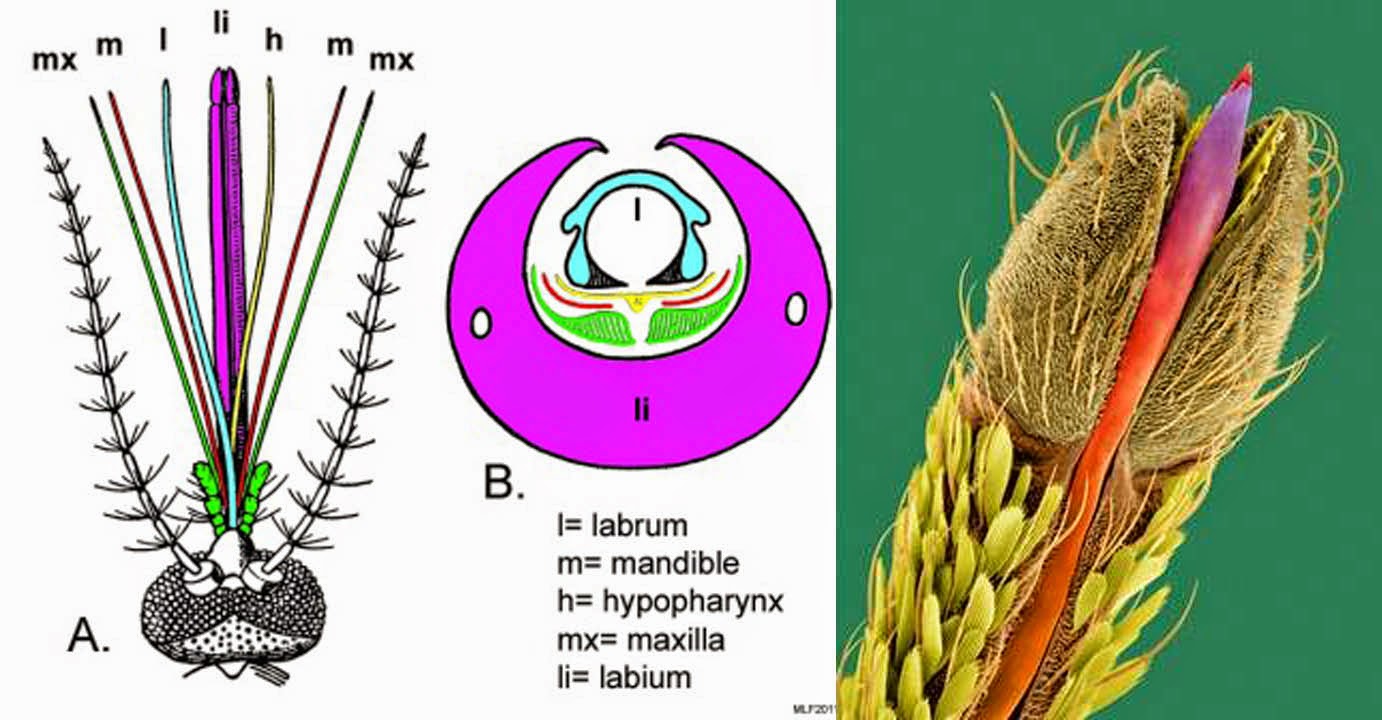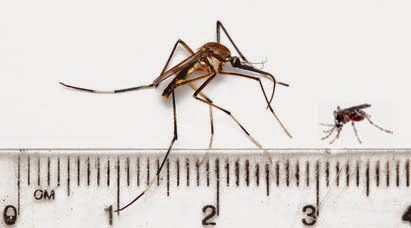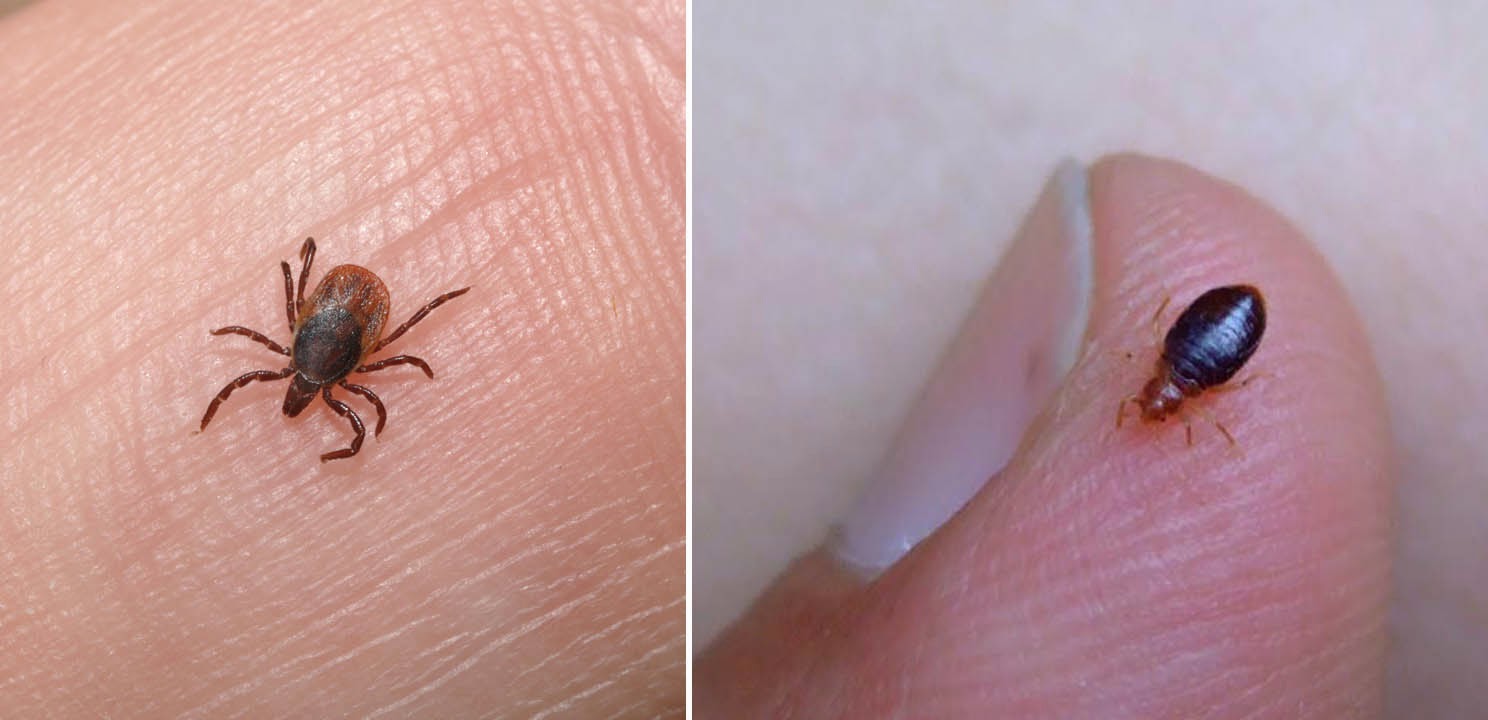Biology
We can start our summer series of biology questions by continuing our discussion of taste and thermosensing. It seems that some people are bitten by mosquitoes if they peak out the front door, while other people can sit outside next to tall grass or ponds for hours with suffering a single bite. Unfortunately, I happen to be in the former category.
Take a look at these videos taken from a 2012 PLoS One study of a mosquito biting a mouse. The squarish objects are skin cells, and the red streaks are blood vessels. The second video in the sequence shows what happens when the proboscis finds a vessel and starts to suck out the blood. Makes you respect the mosquito a bit more ? these are some determined females.
But here is one of our exceptions ? some mosquitoes have gotten around the need for blood meals. All 92 species of mosquito in the genus Toxorhynchites (elephant mosquito) don?t need to feed on blood. Instead, their larvae feed on the larva of other mosquitoes, and the gather the proteins they need to lay viable eggs from their larval meals. They store the amino acids in their larval and pupal bodies, until they become adults and need them to lay eggs of their own.
But just because they feed mostly from birds doesn?t mean they aren?t important disease transmission. They are ? for horses. Eastern equine encephalitis virus is passed from bird to bird by C. melanura, so the birds, especially cardinals, are a reservoir of virus. Then, when another species of mosquito that is less particular about its host species bite a bird then bites a horse or person, the disease can be spread. There are even cases where a C. melanura will occasionally feed on a human and spread the disease directly.
Bacteria feed on the sweat, sugars and proteins that mammals exude, and they give even more semiochemicals. This can make you more or less attractive to mosquitoes. In general, people with many types of bacteria on their skin are less attractive, while those with mostly a few attractive species will get bitten more often. Having a high number of bacteria is a turn off too, probably because that would expose the mosquitoes to more possible pathogens as well. Is it possible to be so disgustingly colonized that even mosquitoes won?t land on you?
But what was old is new again?. Scientists are again looking at heat as an attractant for mosquitoes. As compared to HA or LA socks, heat isn?t a strong attractor, but warm socks attract more mosquitoes than cold socks. On the other hand, a 2010 study says that heat and moisture is a greater attractor than heat alone, so it would seem that people working outside in the heat would be the perfect attractors for mosquitoes.
But in birds, reptiles and insects, TRPA1 is a heat sensor. The 2009 studyshowed that the TRPA1 were expressed on the female antennae only. But that isn?t to say that only female mosquitoes have TRPA1. A 2013 study indicates that A. gambiae mosquito larvae have functioning TRPA1 so that they can sense water temperature and stay in the most comfortable water.
Maekawa E, Aonuma H, Nelson B, Yoshimura A, Tokunaga F, Fukumoto S, & Kanuka H (2011). The role of proboscis of the malaria vector mosquito Anopheles stephensi in host-seeking behavior. Parasites & vectors, 4 PMID: 21272298
Albeny-Simões D, Murrell EG, Elliot SL, Andrade MR, Lima E, Juliano SA, & Vilela EF (2014). Attracted to the enemy: Aedes aegypti prefers oviposition sites with predator-killed conspecifics. Oecologia, 175 (2), 481-92 PMID: 24590205
Olanga EA, Okal MN, Mbadi PA, Kokwaro ED, & Mukabana WR (2010). Attraction of Anopheles gambiae to odour baits augmented with heat and moisture. Malaria journal, 9 PMID: 20051143
Liu C, & Zwiebel LJ (2013). Molecular characterization of larval peripheral thermosensory responses of the malaria vector mosquito Anopheles gambiae. PloS one, 8 (8) PMID: 23940815
- # 56 Summary Of Infectious Diseases And Antibiotics
1 The term disease is defined as a disorder or illness that disrupts the normal functioning of the body or mind. Infectious diseases are caused by organisms known as pathogens that invade the body. Non-infectious diseases are all other diseases that are...
- #55 Infectious Diseases And Antibiotics
An infectious disease is one that can be passed between one person and another. Infectious diseases are caused by pathogens. These are usually microorganisms such as viruses, bacteria, fungi or protoctists. A non-infectious disease cannot be passed between...
- Human Health And Infectious Diseases
Health is a state of complete physical, mental & social well-being. Health is affected by genetic disorders, Infections, change in life style (food, water, rest, exercise, habits etc).Diseases may be Infectious or Non-infectious. Pathogens: Disease...
- Dragonfly Facts
Dragonflies have been around 300 million years. One prehistoric fossil had a wingspan of 2 1/2 feet! Today, the largest dragonfly is found in Costa Rica. It has a wingspan of 7 1/2 inches. Dragonfly eyes contain up to 30,000 individual lenses....
- Taste And Be Tasted ? Fair Is Fair
Biology concepts ? metamerism, tagmentizaton, taste, arthropods, receptor, parasitism Carbonated sodas come in all flavors, but across all cultures, it is the carbonation that is the same. Mauby is a tree bark flavored soda sold in the West Indies...
Biology
How Do Mosquitoes Find You?
Biology concepts ? semiochemicals, hematophagy, proboscis, thermosensing, TRPA1
 |
| Sure, mosquitoes suck blood and pass along malaria that kill more humans than any other infectious disease. But would it be good to get rid of them. They provide food for birds ? one scientist suggests that elimination of Arctic mosquitoes could reduce northern bird populations by 50%. And mosquitoes pollinate flowers too, like blueberries and cranberries. See, they?re not all bad. |
How do mosquitoes find some people and not others? Are some people just tastier than others?
First let?s get some common misconceptions and basic information out of the way. Do mosquitoes bite you (or any other animal)? No, they have no teeth, so they don?t bite in the traditional sense. What they do have is an elongated set of mouthparts called a proboscis. The sheath on the outside retracts as the longer parts inside pierce the skin like a hypodermic needle. Only this is a flexible hypodermic needle, small enough to go around individual cells and look for a small vein or venule.
 |
| On the left is a drawing of the mosquito proboscis parts. Most sit in a groove of the labium, which retracts as the rest is injected into the skin. The maxillae and mandibles are like our upper and lower jaws. They are the sharp parts. The hypopharynx is what delivers the anticoagulant saliva. On the right is the parts put together. The fuzzy part is the labium and the sharp tips are from the maxillae. |
Of course it?s only the females that feed on blood. This suggests that feeding on blood is related to having babies. And it is ? just not in a ?gotta get the baby some food? sort of way. Most mosquito species require a blood meal in order to develop viable eggs. Females get energy from drinking nectar (full of carbohydrates), but they need protein to produce yolk for the eggs. They get the protein from feeding on blood. If the female doesn?t feed on blood, the eggs will be produced, but they won?t be able to hatch and become larva.
But here is one of our exceptions ? some mosquitoes have gotten around the need for blood meals. All 92 species of mosquito in the genus Toxorhynchites (elephant mosquito) don?t need to feed on blood. Instead, their larvae feed on the larva of other mosquitoes, and the gather the proteins they need to lay viable eggs from their larval meals. They store the amino acids in their larval and pupal bodies, until they become adults and need them to lay eggs of their own.
Compare the sizes of the elephant mosquito (left) and A. aegypti. I?m very glad that the females of the Toxorhynchites genus don?t suck blood. They could drain people dry! Even though their size is small, species like the one on the right can consume 300 ml a day from every caribou in a herd when they are swarming.

Compare the sizes of the elephant mosquito (left) and
A. aegypti. I?m very glad that the females of the
Toxorhynchites genus don?t suck blood. They could drain
people dry! Even though their size is small, species like the
one on the right can consume 300 ml a day from every
caribou in a herd when they are swarming.
This suggests that the elephant mosquitoes could be used to combat disease spreading mosquitoes, like the Aedes aegypti mosquitoes that spread dengue fever, yellow fever and the current disease of interest, chikungunya fever. And the elephant mosquito has been used as a natural biocontrol agent. What's weird is that A. aegypti females actually help the situation.
A. aegypti, and many other mosquitoes that lay eggs in water, have larvae that eat bacteria. So they want to lay eggs where there are a lot of bacteria. Well, the eating of larvae by Toxorhynchitesspecies leaves lots of little pieces of mosquito larva in the water, and this provides bacteria with a lot of food. A June 2014 study showed that A. aegypti females actually prefer to lay eggs in water that contain predators for their larva, because it increases the bacterial numbers so much. Thos that survive have lots of bacteria to feed on. It?s a calculated behavior ? risk being eaten or risk starving.
So some mosquitoes will go a long way and risk death in order to get a good meal for their potential offspring. They?re looking for mammals usually, but even here there are exceptions. Some mosquito species, like Culiseta melanura, feed almost exclusively on bird blood ? they say it tastes like chicken.
 |
| The picture represents the transmission cycle for eastern equine encephalitis virus (EEEV). It can?t be transmitted from mammals to other animals, so they are called dead-end hosts. But it can produce disease in them. Humans most often will present with a limiting or subclinical disease, but horses have a hard time with it. The major source is in birds, and the transmission from bird to bird is by mosquitoes that rarely bite humans. The way into dead-end hosts is by a mosquito that normally bites mammals occasionally biting a bird, or the rare occasion that a bird specific mosquito will bit a mammal. |
With this background, we still need to answer our question of the day ? how do mosquitoes find a blood meal. Believe it or not, your socks help answer the question. For many years it was assumed that mosquitoes followed the heat of warm-blooded animals in order to find a meal, but this was an assumption that was not tested rigorously.
Then it was discovered that carbon dioxide (CO2) is a strong cue for mosquitoes seeking sustenance. CO2 means respiration, and respiration possibly means mammals. The mosquitoes have taste receptors in their antennae and mouths that will sense changes in CO2 and they will follow the path of more carbon dioxide right to your nose and mouth (see this post).
Large people and pregnant women tend to exhale more CO2, so they will be more attractive to mosquitoes. But there are large individuals who never get bothered by mosquitoes. Maybe there?s more to it.
Semiochemicals are part of the answer. Semio- comes from the Greek meaning signal, like in semaphore flags. So semiochemicals are molecules emitted by organisms for communication. Pheromones are the most famous of the semiochemicals ? and we know that these are used in many animals, from helping to guide ants to follow the path of their predecessors, to influencing mate choices in many animals.
Semiochemicals might be attractants or repellants. In some cases, they can be both. Take human body odor ? it contains dozens of semiochemicals, people find body odor repulsive, but mosquitoes enjoy it like the smell of fresh apple pie. Of course, body odor is only offensive nowadays; before the advent of deodorant, daily or three times daily baths and showers, perfume, aftershave, and of course Axe products ? everybody smelled like that guy that lives under the bridge.
 |
| On the top of this image is a general idea of semiochemicals. If they work on members of the same species (like mating signals), then they are called pheromones. If they work on other species, they are called alleochemicals. Each can be either attractive or repellant. On the bottom is a homemade mosquito trap. You might be able to see that it has been baited with old shoes and grimy socks. |
Mosquitoes are attracted to several different semiochemicals, including octenol, CO2, and nonanal. On mosquito antennae, especially the female antennae, there are receptors in the sensilla (see this post) for at least 27 different chemicals in human sweat.
Studies have shown that old socks are a good experimental attractant for mosquitoes. Instead of using an arm or other body part, scientists will compare the attractive ability of someone?s old sweat socks to individual chemicals or mixtures of chemicals. Of course, whose socks you use matters as well. Some people are classified as high attractors (HA) and some as low attractors (LA), so studies often include comparisons of chemicals or mixtures to both HA and LA socks.
But there are other considerations as well. People with blood type O secrete different semiochemicals and are more attractive to many species of mosquitoes. Go ahead, try to change your blood type so you?re less attractive to mosquitoes.
Different species may aim for different body parts. Some seem to prefer feet and ankles, but this may be because they are closer to the ground. If convection currents created by the body heat rising suck the mosquitoes in from below, then it is really the fact that they are following their noses and not going after feet particularly. A small 1998 study showed that mosquitoes that went after feet and ankles preferentially did not do so when the volunteers lied on their backs and raised their feet high in to the air. But, what we have stumbled across in this discussion is body heat.
 |
| This is part of a complex figure from a 2011 scientific paper. In addition to the pretty colors used, the message is that these researchers identified TRPA1 ion channels on the proboscis of a species of mosquito. They don?t just sense heat with their antennae, but also their sucking parts. I wonder if the interior parts also have TRPA1 to help them find a vessel when the proboscis is inserted into the tissue. |
Since heat does seem to be an attractor, it would follow that female mosquitoes would have a receptor for heat. Voila, a new study shows that mosquitoes have sensilla on their antennae and palps that house TRPA1 ion channels. A 2011 study even showed that one malaria-carrying mosquito has TRPA1 receptors on its proboscis. We have talked before about how many mammals use this receptor to sense noxious cold as well as chemicals that cause irritation or pain.
 |
| On the left is a species of tick. You wouldn?t believe how big they can get when feeding on blood. Look it up ? I dare you. On the right is a bedbug. The bedbug is not that closely related to the tick, since the tick is an arachnid. Count the legs on each ? spiders (arachnids) have eight legs, insects have six. Both these animals feed on blood, but no one has identified a heat sensor in them. |
So mosquitoes (most female mosquitoes) are finding suitable hosts for blood meals by using their senses of taste, smell, sight, and infrared detection. There are other vampire insects as well, ticks, bedbugs, etc. I wonder if they are using heat sensing too. These have yet to be reported on.
Next week, a related question ? just how and why do mosquito repellants work?
- # 56 Summary Of Infectious Diseases And Antibiotics
1 The term disease is defined as a disorder or illness that disrupts the normal functioning of the body or mind. Infectious diseases are caused by organisms known as pathogens that invade the body. Non-infectious diseases are all other diseases that are...
- #55 Infectious Diseases And Antibiotics
An infectious disease is one that can be passed between one person and another. Infectious diseases are caused by pathogens. These are usually microorganisms such as viruses, bacteria, fungi or protoctists. A non-infectious disease cannot be passed between...
- Human Health And Infectious Diseases
Health is a state of complete physical, mental & social well-being. Health is affected by genetic disorders, Infections, change in life style (food, water, rest, exercise, habits etc).Diseases may be Infectious or Non-infectious. Pathogens: Disease...
- Dragonfly Facts
Dragonflies have been around 300 million years. One prehistoric fossil had a wingspan of 2 1/2 feet! Today, the largest dragonfly is found in Costa Rica. It has a wingspan of 7 1/2 inches. Dragonfly eyes contain up to 30,000 individual lenses....
- Taste And Be Tasted ? Fair Is Fair
Biology concepts ? metamerism, tagmentizaton, taste, arthropods, receptor, parasitism Carbonated sodas come in all flavors, but across all cultures, it is the carbonation that is the same. Mauby is a tree bark flavored soda sold in the West Indies...
